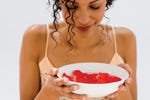February 26, 2011

Customers have been buying more flowers lately, but not in the form you might think. An increased awareness of the tie between emotional and physical health is raising consumer interest in flower essences—tinctures that purportedly capture the energetic healing imprint of everything from alpine lilies to yarrow.
 Just as overall personal care sales began picking up again after a brief decline, flower-essence sales increased from October 2009 to October 2010 by 5.1 percent in the combined conventional and natural channels, according to SPINS, a market research firm in Schaumburg, Ill. Sales rose 2 percent in the natural channel during this time and 19 percent in the conventional channel. This data does not include sales figures from Whole Foods Market or Walmart.
Just as overall personal care sales began picking up again after a brief decline, flower-essence sales increased from October 2009 to October 2010 by 5.1 percent in the combined conventional and natural channels, according to SPINS, a market research firm in Schaumburg, Ill. Sales rose 2 percent in the natural channel during this time and 19 percent in the conventional channel. This data does not include sales figures from Whole Foods Market or Walmart.
“Flower essences are popular because they are an inexpensive and cost-effective therapy that produces potent, powerful effects when dealing with emotional conditions,” says Dick Thom, ND, DDS, a professor at the National College of Naturopathic Medicine in Portland, Ore. For example, flower essences can help calm anxiety, increase happiness in a depressed person or bring focus to someone who feels scattered, he says.
How flower essences are made
Manufacturers create flower essences by placing a flower in spring water and either exposing it to sunlight or boiling it. The water is later extracted to create the flower essence. “In nature, everything has an energy associated with it,” Thom says. “Flower essences are made literally by having the sun shine through the petals, and then that energetic imprint that comes from the flowers is captured in the water and gives us an overwhelmingly positive feeling when we take it.”
Flower essences differ from essential oils. Although both can support emotional wellness, essential oils are extracts of specific components within the plant material. Flower essences capture the flower’s energy imprint, not its specific molecular components, Thom says.
Flower essences differ from homeopathic preparations as well. Homeopathy is based on the concept that “like cures like,” or the idea that the natural extracts and medicinal substances that cause symptoms of physical, rather than emotional, illness can also relieve them. Traditional homeopathic preparations are highly diluted substances derived from plant, animal or mineral sources. Unlike flower essences, they are usually diluted with distilled water or ethyl alcohol, in varying amounts.
Why flower essences work
To date, no double-blind placebo studies prove the effectiveness of flower essences. Anecdotally, Thom has found flower essences to be effective after decades of use with patients. He consults Flower Essence Repertory by Patricia Kaminski and Richard Katz (Flower Essence Society, 1994) as a reference. Knowledge of the healing properties of each flower is the result of hundreds of years of research and observation of the effects of flowers on people and animals, Thom says.
A budding trend
The use of flower essences is on the rise, says Curt Finckler, marketing director for London-based Nelsons, owner of Bach Original Flower Remedies, due to emerging health care trends that consider emotional well-being when looking at the overall health of an individual. “People are realizing that in order to have a physically healthy life, they have to take care of their emotions as well,” Finckler says.
Customers use flower essences to energize, relax and de-stress, he says. Bach’s Rescue Remedy, a combination of flower essences designed to address stress and anxiety, is the company’s number-one seller.
Another trend, notes David Levine, founder of Crestone, Colo.-based Dharma Medicines, is the purchase of what he calls intentional, rather than reaction-based, products. “Americans are starting to understand that they can intentionally create personal health and well-being as opposed to just treating what they want to remedy.” It’s about being proactive instead of reactive, he says. For example, if a person anticipates that an event or situation may make him feel anxious, he will purchase and use a specific flower essence to assist him in feeling less anxious before the next event instead of using it to feel better after the event is over, Levine explains.
A third trend is the use of flower essences for pets. “Three-quarters of our customer-service calls are pet related,” Finckler says. Customers give flower essences to their pets to address the same concerns as humans, such as relieving anxiety and stress and easing fears.
Educating consumers about the healing properties of flower essences is key to encouraging sales. Both Finckler and Levine recommend easy entry points. Offer one condition-based flower essence, for example, geared toward a common emotional concern, such as stress. Or suggest one option for a different mood, such as relaxation, along with the tincture that can provide it, and gradually build from there.
Emotional uses of flower essences
Alpine lily supports the ability to conceive and sustain pregnancy for women who’ve had miscarriages.
Chamomile creates a sense of peace in someone who is upset, reduces high blood pressure and treats insomnia.
Crab apple aids cleansing and detoxification in people who are so concerned about physical impurities that they are reluctant to leave their home.
Madia encourages focus and concentration for people who have a hard time staying on track.
Olive offers a boost of energy for people with emotional fatigue.
Walnut reduces stress for those going through a life transition.
Wild oak helps encourage clarity and direction for people who are dissatisfied with their lives.
Yarrow creates inner harmony and protects against environ-mental pollution, allergies and electronic overload.
About the Author
You May Also Like
.png?width=700&auto=webp&quality=80&disable=upscale)





